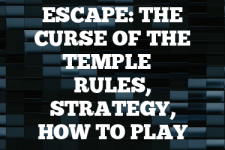Teotihuacan: City of Gods – A Guide to Building the Greatest Mesoamerican Metropolis (Rules, Strategy)
Introduction
Teotihuacan: City of Gods is a strategic board game where players take on the role of noble families in the ancient city of Teotihuacan (pronounced out loud like tay·uh·tee·waa·kaan, for anyone like me who was wondering). The game is all about building and decorating a central pyramid, managing resources, and honoring the gods to gain their favor. It’s set in the pre-Columbian era, and the game’s theme is deeply rooted in the history and culture of the Teotihuacan civilization. The game was designed by Daniele Tascini and published in 2018. It’s known for its deep gameplay and beautiful art that captures the essence of the ancient city, with generally favorable reviews in board gaming communities I frequent.

The game is played over three rounds, called eclipses, and the player with the most victory points at the end wins. Points can be scored in various ways, such as advancing on the temple tracks, decorating the pyramid, housing workers, and collecting masks. The game ends after the third eclipse, and there are many paths to victory, making each playthrough unique.
Quick Tip for Teotihuacan: City of Gods
Focus on a strategy early, but stay flexible. It’s important to adapt to the tiles and resources available each round.
Rules for playing Teotihuacan: City of Gods
Teotihuacan: City of Gods is a game for 1 to 4 players, and it usually takes about 90 to 120 minutes to play. The rules are quite detailed, but I’ll break them down for you.
Each player starts with a set of colored worker dice, which represent their workforce. These dice move around action boards, and the number on each die indicates the worker’s power. When you take an action, you’ll often have the chance to increase your worker’s power. If a worker reaches a power of 6 and takes an action, they ascend, becoming more powerful and granting you a bonus.
Players can take one of three main actions on their turn: move a worker, unlock a worker, or use a special action. Moving a worker allows you to perform an action on the board where the worker lands. Unlocking a worker frees them up so they can be moved again on your next turn. Special actions come from various sources, like buildings or technologies, and can provide unique benefits.
The game’s action boards are where most of the gameplay happens. There are eight of them, each offering different actions like gathering resources, building the pyramid, decorating the pyramid, increasing your workers’ power, and advancing on temple tracks. The temple tracks represent the favor of the gods and can grant you resources, points, or other advantages.
At the end of each round, there’s an eclipse phase. During this phase, players score points based on their progress on the temple tracks and their contributions to the pyramid. They also feed their workers, using cocoa, one of the game’s resources. If you can’t feed your workers, you’ll lose points. After scoring, the game resets some elements, and a new round begins.
After the third eclipse, the game ends, and final scoring takes place. Players get points for leftover resources, their position on the Avenue of the Dead track, and any other end-game bonuses. The player with the most points is declared the winner.
Equipment and Setup for Teotihuacan: City of Gods
To play Teotihuacan: City of Gods, you’ll need the game box, which includes a main board, action boards, tiles, dice, and various tokens and markers. The game’s tiles include resource tiles, decoration tiles, pyramid tiles, and technology tiles, each with its own function.
Setting up the game involves placing the main board in the center of the table and arranging the action boards around it. You’ll shuffle and place tiles on their respective spaces on the boards. Each player chooses a color and takes the corresponding dice, starting tiles, and tokens. You’ll also set up the temple tracks and the Avenue of the Dead track.
If you don’t have the game or want to try a DIY version, you can create your own tiles and boards, though it’s quite a task. The official game components are recommended for the best experience.
How to Play Teotihuacan: City of Gods and Game Mechanics
The key game mechanics in Teotihuacan: City of Gods involve worker movement, resource management, and strategic planning. Here’s a breakdown of how to play:
- Setup: Prepare the game as described in the Equipment and Setup section.
- Gameplay: Players take turns moving their workers around the action boards, taking actions, and managing resources. Each turn, you can move one worker up to three spaces clockwise around the action boards.
- End of the Game: After the third eclipse, perform final scoring. The player with the most points wins.
During gameplay, you’ll encounter various phases:
- Worker Movement: Move a worker dice to an action board and optionally pay cocoa if other players’ workers are there.
- Action Resolution: Perform the action of the board where your worker landed. This could involve collecting resources, building, or advancing on temple tracks.
- Worker Advancement: Increase your worker’s power by advancing the die number. If a worker reaches power 6, they ascend, granting you a bonus.
- Eclipse Scoring: At the end of each round, score points based on your progress on temple tracks and pyramid contributions. Feed your workers with cocoa.
How to Win at Teotihuacan: City of Gods
Winning at Teotihuacan: City of Gods requires a mix of long-term strategy and short-term tactics. Beginners should focus on understanding how each action board works and how to efficiently gather resources. Intermediate players can start to plan their moves in advance, anticipating other players’ actions. Advanced players will need to optimize their turns, make the most of ascended workers, and carefully manage their resources to maximize points.
It’s important to balance your actions between building the pyramid, advancing on temple tracks, and other point-scoring opportunities. Pay attention to the timing of eclipses and plan your moves to score big during these phases. Also, keep an eye on your opponents’ strategies and adapt your plan to stay ahead.
Best Strategies for playing Teotihuacan: City of Gods game
To win at Teotihuacan: City of Gods, you’ll need to employ some clever strategies. Here are a few to consider:
- Focus on a few temple tracks to gain significant bonuses and points.
- Build and decorate the pyramid efficiently to score points during eclipses.
- Manage your cocoa and resources carefully to avoid penalties and maximize your actions.
- Use technology tiles to enhance your strategy and gain advantages over your opponents.
- Plan for worker ascension to get timely bonuses that align with your strategy.
Sneaky tactics can also come into play. For example, you might move to an action board just before another player to force them to pay you cocoa. Or you could strategically lock workers to limit other players’ options.
Scenarios
During the game, you might find yourself in various scenarios. If you’re low on resources, focus on actions that provide what you need without spending too much cocoa. If you’re behind on temple tracks, consider actions that let you catch up quickly.
If you’re ahead, think about how to block your opponents or secure your lead. Always be ready to adapt your strategy based on the current game state and what your opponents are doing.
Frequently Asked Questions about playing Teotihuacan: City of Gods game
Here are some common questions and answers:
- Q: What happens when a worker ascends?
- A: You increase the die to 1, gain a bonus, and may choose to worship, which can give you additional benefits.
- Q: Can I move my worker more than three spaces?
- A: No, workers can only move up to three spaces per turn.
- Q: How do I get more cocoa?
- A: You can get cocoa by taking the collect cocoa action or through certain temple bonuses.
- Q: What if I can’t feed my workers during an eclipse?
- A: You lose three points for each cocoa you can’t pay.
- Q: Can I perform the same action multiple times in a row?
- A: Yes, but you’ll need to unlock your worker or use another worker to do so.
External Links
For more information about Teotihuacan: City of Gods, check out these links:

Eve Brownlee was a gamer before gaming communities on the internet were a thing. Eve grew up playing traditional, standard deck card games like Rummy and Bezique, taking an interest in the classics Backgammon and Chess. Parlor card games like Bridge continue to keep Eve active in the community. After a long career, primarily in horticulture for USDA in Maryland, Eve now travels and writes on The Pineapple (pineapples.info) and contributes to Quora/Pinterest topics. Contact Eve via email.



